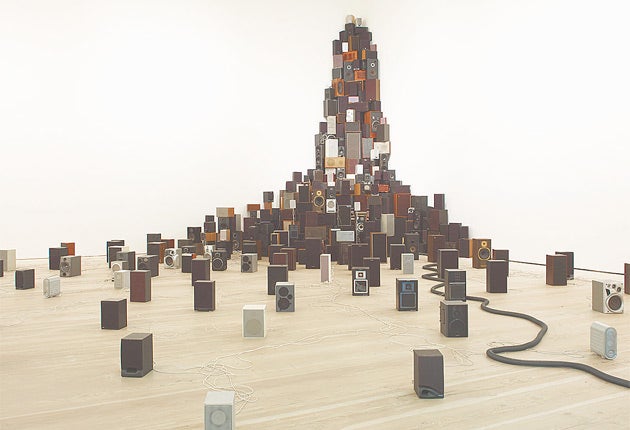Newspeak: British Art Now, The Saatchi Gallery, London
A greyer and wiser Charles Saatchi – 67 this week – puts on a show that has little truck with novelty and is all the better for it

Your support helps us to tell the story
From reproductive rights to climate change to Big Tech, The Independent is on the ground when the story is developing. Whether it's investigating the financials of Elon Musk's pro-Trump PAC or producing our latest documentary, 'The A Word', which shines a light on the American women fighting for reproductive rights, we know how important it is to parse out the facts from the messaging.
At such a critical moment in US history, we need reporters on the ground. Your donation allows us to keep sending journalists to speak to both sides of the story.
The Independent is trusted by Americans across the entire political spectrum. And unlike many other quality news outlets, we choose not to lock Americans out of our reporting and analysis with paywalls. We believe quality journalism should be available to everyone, paid for by those who can afford it.
Your support makes all the difference.You will, I am sure, recall Charles Saatchi, the man who gave us "Labour isn't working" in 1979 and, six years later, the first of a trio of self-styled Galleries. It was Saatchi whose collection of Young British Art brought the YBAs to broad public attention when it was shown at the Royal Academy in Sensation! in 1997, he whose favour or princely neglect can make or break the career of a Goldsmiths' graduate. In recent years, Saatchi's restless eye has roved abroad, to China and India, to the Middle East. But when the latest Saatchi Gallery – the biggest and most handsome yet – holds a show subtitled British Art Now, the world and its dealers still sit up and listen.
As you'd guess, Newspeak comes larded with expectations. Charles Saatchi is famous for spotting talent before anyone else, often when it is still in its second year at art school. When he started collecting Emin and Hirst, they were relative nobodies. If Saatchi says a thing is new and best, then it is new and best. Or that has been his reputation, echoed in the title of this latest show.
But does it still hold good? Although it seems impossible, Saatchi turns 67 this week and is entering his second quarter-century as a gallerist and his fourth decade as a collector. It is fair to say that art was a novelty to him when he bought his first picture 33 years ago, and that the kind of work that has appealed to him has itself often been novel. If you're going to stretch a point, it's arguable that the obsession with newness of recent British art stemmed, at least in part, from the newness to British art of its most ardent advocate.
So what of the tastes of the greyer and wiser Charles Saatchi? As you'd expect, Newspeak turns out to be not quite as descriptive a title as Sensation! was in 1997. A lot of the work in this latest show seems distinctly oldspeak, either because we have seen it or its makers before – Goshka Macuga in the 2008 Turner Prize show, Pablo Bronstein in the 2006 Tate Triennial – or because it has little clear truck with novelty. Only two of the 29 artists in the show are under 30, and one – gasp! – is 53. None is a student. Of the artists in Sensation! – Jake and Dinos, Chris Ofili, Hirst, Harvey, Whiteread and Emin – not one is in Newspeak. The word "now" has clearly changed its meaning for Saatchi, ageing as he himself has aged. "Now" in 2010 means "new to the Saatchi Collection", although it certainly does not mean "new to art".
And, to my bufferish tastes, Newspeak is all the better for it. Yes, the show is inchoate and inconsistent and a mess, but then it is, in effect, the contents of someone's attic. Some of the work may make you want to tut, but none that I can think of makes you want to call the cops: there are no Myra Hindleys, no impaled Popes, no poo-virgins. And a surprising amount of it – say, 20 per cent – is really very good, and it is on these works that I shall kindly dwell.
In no particular order, and starting in two dimensions: Hurvin Anderson's Untitled (Black Street) feels like real painting, going back to various of the shibboleths of modernism – a monochrome palette, flatness to the picture plane – and finding in them something new, hybrid and disturbing. William Daniel's William Blake II has the recycled, Thomas Demand-ish air of an object remade in paper, photographed and painted. I'm sure it's asking Goldsmithy questions about appropriation, blah blah blah, but it's also heartfelt and uncanny. Barry Reigate's Real Special Very Painting is, both despite and because of its rigid messiness, exactly what it says it is.
Into three dimensions, Matthew Darbyshire's Untitled: Furniture Island No 2 has something of the feel of the early Tony Cragg, that happy, pre-rich moment when Cragg had to scour the banks of German rivers for washed-up bleach bottles. Darbyshire's assemblage of Ikea bits and bobs is funny and pretty and unplaceable, like Arte Povera rethought by Andy Warhol. Of Rupert Norfolk's Guillotine I can not say enough, the rendering duplicitous of a machine whose job it is to cut things in two being little short of genius. And John Wynne's Installation for 300 speakers etc has a frail monumentalism that you really have to see and hear. If this is the older Saatchi's idea of newness, then I'm all for it. Happy birthday for Wednesday, Charles.
To 17 Oct (020-7811 3070)
Join our commenting forum
Join thought-provoking conversations, follow other Independent readers and see their replies
Comments